The bottom of the great and early R. Lalique Box was knocked off the counter and is gone forever. The R. Lalique Decanter bottom is krizzled, glass sick, or just cracked. The stopper to that great R. Lalique Perfume Bottle was dropped on the tile floor and is no more (that rhyme was not on-purpose). Many a collector, owner, or dealer has faced just these circumstances and many of these tales of woe find their way to the inbox here at World Headquarters!
One email on this subject, a non-woeful one at that, caused us to reflect a bit on these common occurrences and we thought we’d write a little about the whole subject of replaced parts because it comes up surprisingly often.
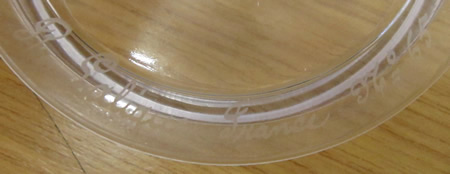
For starters we want to limit what we are talking about. We are only talking about pieces that have common parts originally made just that way by Rene Lalique Et Cie prior to the end of World War II in France.
So modern reproduced parts are not within the scope, including anything made by the modern Lalique company in crystal after the death of Rene Lalique. Also, a part made new after the war to look like an authentic part is also not within the scope (see the Faked Cluny or Senlis Vase story).
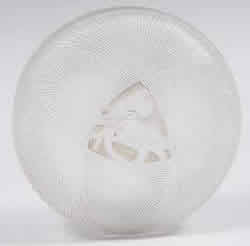 And this includes parts made from actual R. Lalique glass. So for example, if a dealer gets a glass guy to make a new stopper out of the thick base of a broken vase; to literally hand carve the thing from authentic Rene Lalique glass to the point where virtually no one would know the difference, this is not what this article is about.
And this includes parts made from actual R. Lalique glass. So for example, if a dealer gets a glass guy to make a new stopper out of the thick base of a broken vase; to literally hand carve the thing from authentic Rene Lalique glass to the point where virtually no one would know the difference, this is not what this article is about.
And of course, the instance where a dealer takes the entire bottom off of a broken vase, and has it virtually seamlessly installed (better to say “unseemly” installed?) to replace the cracked bottom on another vase is definitely not for this discussion either.
We singled out boxes, decanters and perfume bottles because virtually every one of these items has at least two parts, and each of those parts was made in some volume. And that volume in many instances does not even have to be for the same model piece. For example many decanters share the same bottom; the same “blank”, and the only difference is the stopper (ignoring the addition of a signature, model number, and the scratched matching numbers on the stopper stem and decanter bottom to keep the pieces together during the finishing process). Ignoring the manufacturing differences in the mold blown decanter bottoms and the hand fitting and polishing of the stoppers, the decanter bottoms are meant to be identical in maybe a dozen or so original R. Lalique stemware sets. The bottom to a Colmar decanter is the same model as the bottom to a Obernai Decanter.
So in the spirit of the great American inventor Eli Whitney ***, the parts would be, in a perfect world, interchangeable. So if you break your decanter bottom, you can patiently wait on Ebay for the bottom to your model to come up. Or if you happen to have a model that has the bottom shared by others, for any one of them to come up. Or you can cruise the Paris flea market. Or you can contact RLalique.com and tell us about your “Want”. Of course, we don’t live in a perfect world but it’s close enough that many seemingly hopeless situations can be addressed.
 Sometimes a complete decanter, perfume bottle, or box may come up for sale, but because of the model, or damage to one of the pieces, or just luck of timing, it may go for a low enough price that it pays to buy the whole thing just to get the undamaged part you want (and hope it fits of course).
Sometimes a complete decanter, perfume bottle, or box may come up for sale, but because of the model, or damage to one of the pieces, or just luck of timing, it may go for a low enough price that it pays to buy the whole thing just to get the undamaged part you want (and hope it fits of course).
Well, we thought about all of this when the following email arrived which references the 1st photo above. And note that the names have been removed to protect the innocent of course:):
Dear Info@rlalique,
I have a query that needs your help!
My name is XXX and I work for a YYY based auction house in ZZZ. We have recently had a group of Lalique items consigned to us from a vendor who was left them. Amongst them is a Genevieve powder box. On your website the box is listed as Model Number 57, the one we have has an etched mark but is numbered 65. I cannot find any record of a model 65, can you help me? I have attached a photo of the mark if that helps. Kind regards,
XXX
The good news is the auction house is on the ball. Let’s face it. You got ghosts, where do you go? Actually, does Ghostbusters even have a website? Ok, let’s just move on.
So right away you know the auction house wants to get it right because they got the goods and went straight to RLalique.com and the new Rene Lalique Catalogue here at World Headquarters to make the identification! And they were on the ball enough to know because of the markings on the base (shown in the photo of the signature near the top of this article) that something was amiss. The catalogue says it’s box number 57, the base says it’s number 65. Hmmmm.
Our reply (again with identifying stuff blanked out and some minor grammar fixes to make us sound like we were paying attention in 5th grade English the day they mentioned dangling participle and other unknowable grammar stuff :):
Hi XXX. Thanks for contacting us. We are familiar with your auction house as we list R. Lalique items that come up in your sales in our Worldwide Auction section of the site. The last time was QQQQ.
About your question, it’s not unusual for the bottoms of boxes to be switched as many boxes use a common bottom. This can happen where the same owner has several boxes of the same size that use the same common box bottom. Or if the bottom is broken or lost and a dealer or an owner obtains a good bottom that appears on Ebay or elsewhere (Paris flea market) that has had the top to it break or disappear. Even today, since most of the blank common box bottoms have a signature on them, they can be identified as R. Lalique. And a couple of times a year a blank box bottom appears on Ebay for sale.
With R. Lalique, the same thing can occur with say some of the tableware set decanters, where the same blank was used for the bottom (the container) on maybe a dozen models, and the only difference is the stopper. Bottoms to these decanters do show up on the market from time to time, just like box bottoms, and if your decanter bottom gets glass sickness or gets broken, if you have a model that shares a common bottom, you can find a replacement that may or may not have a different model number written on it. Of course the stopper fitting properly is a bit more problematic with the mold blown decanter bottoms and hand fitted stoppers, than for the much more standard press mold boxes.
Box No. 65 is a box called Gui and it’s a 10 centimeter box just like the Genevieve. These two models actually appear next to each other in the 1932 Catalogue. So what you have is the bottom to a Gui box under a Genevieve box top. The bottoms would be identical other than the signature with that number (assuming the bottom you have is clear glass and not opalescent glass), and for most people it would be a distinction without a difference.
https://rlalique.com/rene-lalique-gui-box (where you can see part of the bottom in one of the photos)
There is also a slim chance that the mistake was made at the factory as very, extremely rarely, we see a mis-numbered piece. But we’d bet on it being a switch or replacement as described above.
And it might pay to talk to the consignor (assuming it’s a private and not a dealer) on the chance the Gui box is with a different family member or can be located and the original mates restored.
If you have any further questions, let us know.
KOL
Of course, now that we let the “yes there are repair guys that can make a stopper from a chunk of glass” fact out of the bag, it goes without saying that a good glass guy could clean up the inscribed number on the bottom of a box :).
And of course, even with mold pressed smaller pieces, due to the manufacturing techniques of the day, as well as possible later polishing to either or both the top and bottom, there might be some minor “fitting” involved even when switching what should be the same basic bases among boxes. A hair taller, a hair thicker would not be out of the question. In that regards consider the following:
We contacted two different owners of incredible box collections. Each checked their Genevieve Box and Gui Box bottoms for us and sent us photos and descriptions. In both photos the Genevieve Box bottom is on the left and the Gui Box bottom is on the right.
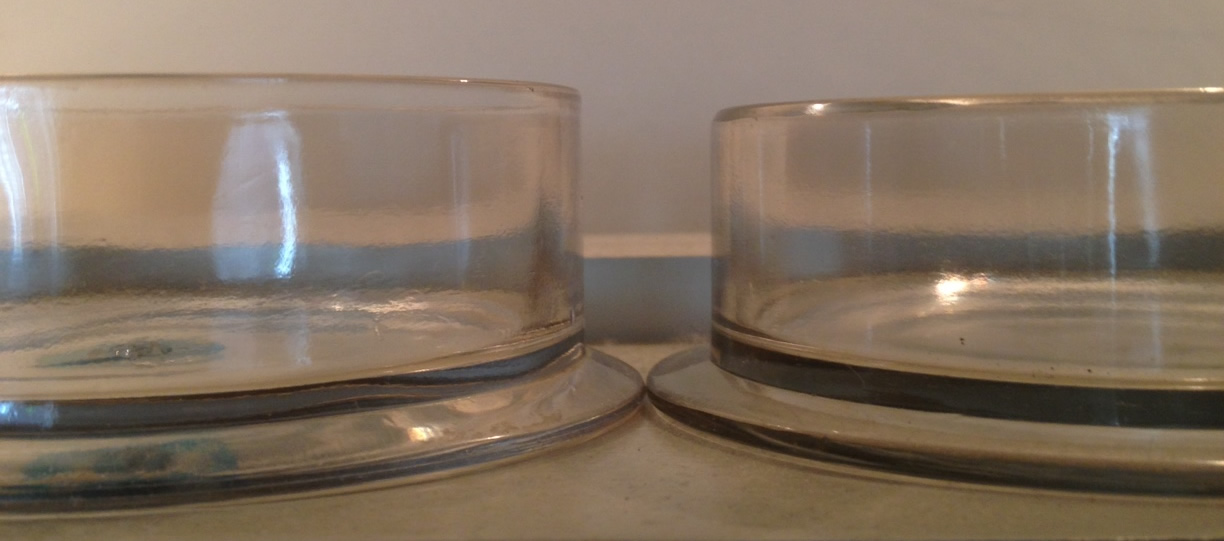
Collector 1 sent a photo (just above) showing their Gui box bottom to be shorter than the Genevieve bottom. And noted that the Gui top could not fit properly on the Genevieve bottom unless that bottom was lowered (polished down) slightly.
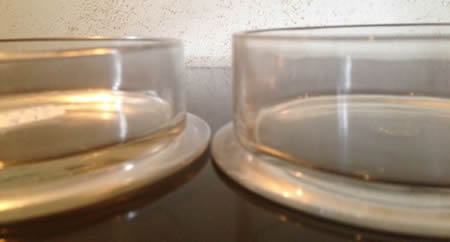
Collector 2 sent a photo (just above) showing their Gui box bottom to be taller than his Genevieve bottom! And this collector noted that the Genevieve box top would not fit over the Gui box bottom unless the Gui bottom was lowered slightly! This is exactly the reverse of Collector 1.
So, either it’s fit and finish at the factory owing to less than exact sizes coming out of the molds at the factory, or later polishing to either the top and/or bottom, or both. But again, the fact remains; the bottoms are basically interchangeable, possibly with some minor glass guy adjusting.
Here is another example of a different replacement part “Want” that was satisfied just last month:
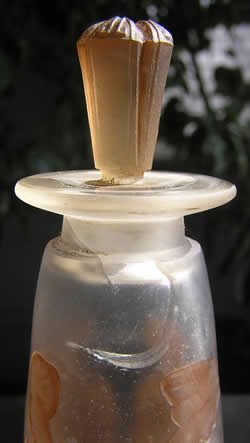 The request (again, ID’s hidden and minor grammar corrections to make everyone look better):
The request (again, ID’s hidden and minor grammar corrections to make everyone look better):
good day to you from AAA, I am looking for the glass stopper for the COTYS AMBRE ANTIQUE perfume bottle. If anyone can help, many thanks BBB
Our reply:
Hi BBB.
Thanks for visiting the website and for contacting us.
BBB, the following Ebay listing appeared yesterday. The bottle is cracked and may sell very cheaply. The listing does not mention any issues with the stopper, though we’d suggest you confirm that with the seller before bidding. And also note that there is no assurance the stopper from one bottle will fit another. But it may be worth a chance.
RENE-LALIQUE-FLACON-FOR-COTY-AMBER-ANTIQUE-CIRCA-1910 Item: 121087944635.
Good luck if you decide to pursue it, and if you don’t get it, let us know and we’ll post your stopper in the wanted section.
Best Regards,
KOL
Their reply:
KOL, thank you so much for spotting this.I will give it a try and let you know. This is the first sniff of a stopper that I have had for a year, so fingers crossed. Best Regards BBB
Our further reply:
Hi BBB. We listed another one of these today that’s at a small house in PA. The pic looks rough, but the stopper may be in good order and it seems a reasonable chance for a bargain if it is.
KOL
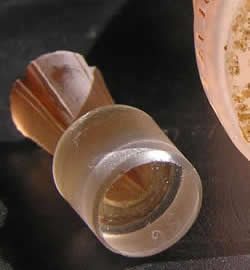 And the last we heard:
And the last we heard:
Hi KOL, with the help from an American buddy here I managed to get that bottle. It has not arrived in the AAA yet but so pleased I have it. All thanks to you and your diligence, so again many thanks for your help. ( think I’ll look for a nice Perruches bowl next. ) BBB
And of course the big question, is there anything wrong here in replacing a missing or broken part with a supposedly or nearly identical original R. Lalique part? Feel free to weigh in with your thoughts in the comments.
*** Eli Whitney was born in 1765 in Massachusetts. He invented the Cotton Gin in 1793. It’s an easily made machine that removes seeds from cotton much faster than the previous hand removal method of picking them out one by one. He later manufactured weapons such as muskets and was an aggressive advocate of manufacturing using interchangeable parts. Whitney had a major impact on the entire United States in the antebellum period. Counterintuitively, though the Cotton Gin was a labor saving device, it made slavery a stronger institution in the South and enriched the South by making previously unprofitable cotton types and fields profitable by lowering the cost of production. Cotton production skyrocketed after the introduction of the cotton gin, slave labor became highly profitable, and a declining slave industry was re-invigorated. In the 17 years after the appearance of the Cotton Gin, U.S. cotton exports grew by nearly 200 times! Not 200 percent, but 200 times! As a result, in the decades before the Civil War, cotton accounted for over one-half of all U.S. exports.
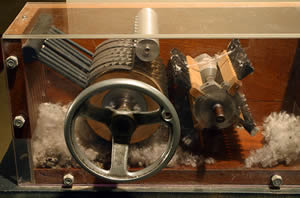 On the other hand, while the South was engaged in a vast agricultural based commercial and wealth expansion because of the cotton gin, his push to manufacture with interchangeable parts strengthened the North’s existing industrial advantage over the South, and thereby contributed significantly to the North’s victory in the Civil War.
On the other hand, while the South was engaged in a vast agricultural based commercial and wealth expansion because of the cotton gin, his push to manufacture with interchangeable parts strengthened the North’s existing industrial advantage over the South, and thereby contributed significantly to the North’s victory in the Civil War.
All Articles on These Topics: R Lalique Decanters and Rene Lalique Decanters, Rene Lalique Boxes and R Lalique Covered Boxes, Rene Lalique Perfume Bottles - R Lalique Perfumes

